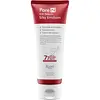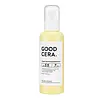What's inside
What's inside
 Key Ingredients
Key Ingredients

 Benefits
Benefits

 Concerns
Concerns

 Ingredients Side-by-side
Ingredients Side-by-side

Water
Skin ConditioningOpuntia Coccinellifera Fruit Extract
Skin ConditioningLavandula Angustifolia Flower/Leaf/Stem Extract
MaskingGlyceryl Linoleate
EmollientElettaria Cardamomum Seed Oil
MaskingSantalum Album Oil
MaskingArgania Spinosa Kernel Oil
EmollientPanthenol
Skin ConditioningResveratrol 3.56%
AntioxidantCyclopentasiloxane
EmollientCitric Acid
BufferingDiospyros Kaki Leaf Extract 38.05%
Skin ProtectingGlyceryl Linolenate
EmollientAscorbyl Palmitate
AntioxidantGlycine Soja Oil
EmollientBiotin
AntiseborrhoeicBis-PEG-18 Methyl Ether Dimethyl Silane
EmollientAcrylates/C10-30 Alkyl Acrylate Crosspolymer
Emulsion StabilisingC12-14 Pareth-12
EmulsifyingAscorbic Acid
AntioxidantMorus Alba Bark Extract
Skin ConditioningCitrus Aurantium Bergamia Fruit Extract
Skin ConditioningCyclohexasiloxane
EmollientCitrus Paradisi Peel Oil
MaskingEnantia Chlorantha Bark Extract
Skin ConditioningDipropylene Glycol
HumectantDimethicone/Vinyl Dimethicone Crosspolymer
Skin ConditioningTocopheryl Acetate
AntioxidantCitrus Tangerina Extract
TonicGlyceryl Arachidonate
EmollientCitrus Aurantium Dulcis Oil
MaskingGlycerin
HumectantPolysilicone-11
Phenoxyethanol
PreservativeGlycyrrhiza Glabra Root Extract
BleachingCastanea Crenata Shell Extract 37.18%
Skin ConditioningDimethicone
EmollientNiacinamide
SmoothingAdenosine
Skin ConditioningCedrus Atlantica Bark Oil
MaskingLactic Acid
BufferingAscorbyl Tetraisopalmitate
AntioxidantLavandula Angustifolia Oil
MaskingRetinol
Skin ConditioningCarbomer
Emulsion StabilisingButylene Glycol
HumectantLitsea Cubeba Fruit Oil
Masking1,2-Hexanediol
Skin ConditioningCitrus Aurantium Dulcis Fruit Extract
MaskingDisodium EDTA
Pelargonium Graveolens Flower Oil
MaskingOleanolic Acid
Skin ConditioningTromethamine
BufferingAmmonium Acryloyldimethyltaurate/Vp Copolymer
Water, Opuntia Coccinellifera Fruit Extract, Lavandula Angustifolia Flower/Leaf/Stem Extract, Glyceryl Linoleate, Elettaria Cardamomum Seed Oil, Santalum Album Oil, Argania Spinosa Kernel Oil, Panthenol, Resveratrol 3.56%, Cyclopentasiloxane, Citric Acid, Diospyros Kaki Leaf Extract 38.05%, Glyceryl Linolenate, Ascorbyl Palmitate, Glycine Soja Oil, Biotin, Bis-PEG-18 Methyl Ether Dimethyl Silane, Acrylates/C10-30 Alkyl Acrylate Crosspolymer, C12-14 Pareth-12, Ascorbic Acid, Morus Alba Bark Extract, Citrus Aurantium Bergamia Fruit Extract, Cyclohexasiloxane, Citrus Paradisi Peel Oil, Enantia Chlorantha Bark Extract, Dipropylene Glycol, Dimethicone/Vinyl Dimethicone Crosspolymer, Tocopheryl Acetate, Citrus Tangerina Extract, Glyceryl Arachidonate, Citrus Aurantium Dulcis Oil, Glycerin, Polysilicone-11, Phenoxyethanol, Glycyrrhiza Glabra Root Extract, Castanea Crenata Shell Extract 37.18%, Dimethicone, Niacinamide, Adenosine, Cedrus Atlantica Bark Oil, Lactic Acid, Ascorbyl Tetraisopalmitate, Lavandula Angustifolia Oil, Retinol, Carbomer, Butylene Glycol, Litsea Cubeba Fruit Oil, 1,2-Hexanediol, Citrus Aurantium Dulcis Fruit Extract, Disodium EDTA, Pelargonium Graveolens Flower Oil, Oleanolic Acid, Tromethamine, Ammonium Acryloyldimethyltaurate/Vp Copolymer
Water
Skin ConditioningHydrogenated Polyisobutene
EmollientCyclopentasiloxane
EmollientBetaine
HumectantGlycerin
HumectantButylene Glycol
HumectantNeopentyl Glycol Dicaprate
Emollient1,2-Hexanediol
Skin ConditioningC14-22 Alcohols
Emulsion StabilisingHydrogenated Lecithin
EmulsifyingDimethicone
EmollientCetearyl Alcohol
EmollientCaprylic/Capric Triglyceride
MaskingC12-20 Alkyl Glucoside
EmulsifyingAmmonium Acryloyldimethyltaurate/Vp Copolymer
Batyl Alcohol
EmollientStearic Acid
CleansingCamellia Oleifera Seed Oil
Skin ConditioningLecithin
EmollientTocopheryl Acetate
AntioxidantEthylhexylglycerin
Skin ConditioningXanthan Gum
EmulsifyingDisodium EDTA
Glyceryl Stearate
EmollientSodium Hyaluronate
HumectantPolyquaternium-51
Skin ConditioningNiacinamide
SmoothingGlycerylamidoethyl Methacrylate/Stearyl Methacrylate Copolymer
HumectantEthylhexyl Isononanoate
EmollientDipropylene Glycol
HumectantAlteromonas Ferment Extract
Skin ConditioningPropylene Glycol
HumectantPhytosteryl/Isostearyl/Cetyl/Stearyl/Behenyl Dimer Dilinoleate
Skin ConditioningBacillus Ferment
Skin ConditioningLavandula Angustifolia Oil
MaskingCeramide NP
Skin ConditioningHydroxypropyl Bispalmitamide Mea
EmollientGlycine Soja Sterols
EmollientYeast Extract
Skin ConditioningMeadowfoam Estolide
Skin ConditioningGlycoproteins
Skin ConditioningGlyceryl Polymethacrylate
Cymbopogon Citratus Leaf Oil
MaskingCitrus Grandis Fruit/Peel Water
HumectantAleuritic Acid
Skin ConditioningTheobroma Cacao Seed Extract
AntioxidantPelargonium Graveolens Oil
MaskingCetearyl Glucoside
EmulsifyingHydrogenated Polydecene
EmollientCitrus Aurantium Dulcis Peel Oil
MaskingSantalum Album Oil
MaskingPogostemon Cablin Leaf Oil
MaskingChamomilla Recutita Flower Oil
MaskingGlycosphingolipids
EmollientGlyceryl Citrate/Lactate/Linoleate/Oleate
EmulsifyingCeteareth-20
CleansingButyrospermum Parkii Butter
Skin ConditioningCeramide AP
Skin ConditioningCeramide EOP
Skin ConditioningWater, Hydrogenated Polyisobutene, Cyclopentasiloxane, Betaine, Glycerin, Butylene Glycol, Neopentyl Glycol Dicaprate, 1,2-Hexanediol, C14-22 Alcohols, Hydrogenated Lecithin, Dimethicone, Cetearyl Alcohol, Caprylic/Capric Triglyceride, C12-20 Alkyl Glucoside, Ammonium Acryloyldimethyltaurate/Vp Copolymer, Batyl Alcohol, Stearic Acid, Camellia Oleifera Seed Oil, Lecithin, Tocopheryl Acetate, Ethylhexylglycerin, Xanthan Gum, Disodium EDTA, Glyceryl Stearate, Sodium Hyaluronate, Polyquaternium-51, Niacinamide, Glycerylamidoethyl Methacrylate/Stearyl Methacrylate Copolymer, Ethylhexyl Isononanoate, Dipropylene Glycol, Alteromonas Ferment Extract, Propylene Glycol, Phytosteryl/Isostearyl/Cetyl/Stearyl/Behenyl Dimer Dilinoleate, Bacillus Ferment, Lavandula Angustifolia Oil, Ceramide NP, Hydroxypropyl Bispalmitamide Mea, Glycine Soja Sterols, Yeast Extract, Meadowfoam Estolide, Glycoproteins, Glyceryl Polymethacrylate, Cymbopogon Citratus Leaf Oil, Citrus Grandis Fruit/Peel Water, Aleuritic Acid, Theobroma Cacao Seed Extract, Pelargonium Graveolens Oil, Cetearyl Glucoside, Hydrogenated Polydecene, Citrus Aurantium Dulcis Peel Oil, Santalum Album Oil, Pogostemon Cablin Leaf Oil, Chamomilla Recutita Flower Oil, Glycosphingolipids, Glyceryl Citrate/Lactate/Linoleate/Oleate, Ceteareth-20, Butyrospermum Parkii Butter, Ceramide AP, Ceramide EOP
Ingredients Explained
These ingredients are found in both products.
Ingredients higher up in an ingredient list are typically present in a larger amount.
1,2-Hexanediol is a synthetic liquid and another multi-functional powerhouse.
It is a:
- Humectant, drawing moisture into the skin
- Emollient, helping to soften skin
- Solvent, dispersing and stabilizing formulas
- Preservative booster, enhancing the antimicrobial activity of other preservatives
Ammonium Acryloyldimethyltaurate/Vp Copolymer (let's call it AAVC for short) is a synthetically created polymer. It's used as a film-forming agent and used to thicken the consistency of products.
AAVC is able to increase the consistency and viscosity of products due to its large molecule size. It also prevents ingredients from separating.
Butylene Glycol (or BG) is used within cosmetic products for a few different reasons:
Overall, Butylene Glycol is a safe and well-rounded ingredient that works well with other ingredients.
Though this ingredient works well with most skin types, some people with sensitive skin may experience a reaction such as allergic rashes, closed comedones, or itchiness.
Learn more about Butylene GlycolCyclopentasiloxane, or D5, is a silicone used to improve texture of products and trap moisture.
D5 is considered lightweight and volatile. Volatile means it evaporates quickly after application. Once evaporated, D5 leaves a thin barrier that helps keep skin hydrated.
It is also an emollient. Emollients help soften the skin and prevent water loss. Silicones create a silky texture in products. D5 helps other ingredients become more spreadable.
Studies show D5 is safe to use in skincare products. We recommend speaking with a skincare professional if you have concerns.
Learn more about CyclopentasiloxaneDimethicone is a type of synthetic silicone created from natural materials such as quartz.
What it does:
Dimethicone comes in different viscosities:
Depending on the viscosity, dimethicone has different properties.
Ingredients lists don't always show which type is used, so we recommend reaching out to the brand if you have questions about the viscosity.
This ingredient is unlikely to cause irritation because it does not get absorbed into skin. However, people with silicone allergies should be careful about using this ingredient.
Note: Dimethicone may contribute to pilling. This is because it is not oil or water soluble, so pilling may occur when layered with products. When mixed with heavy oils in a formula, the outcome is also quite greasy.
Learn more about DimethiconeDipropylene Glycol is a synthetically created humectant, stabilizer, and solvent.
This ingredient helps:
Dipropylene glycol is technically an alcohol, but it belongs to the glycol family (often considered part of the ‘good’ alcohols). This means it is hydrating and gentle on skin unlike drying solvent alcohols like denatured alcohol.
As a masking agent, Dipropylene Glycol can be used to cover the smell of other ingredients. However, it does not have a scent.
Studies show Dipropylene Glycol is considered safe to use in skincare.
Learn more about Dipropylene GlycolDisodium EDTA plays a role in making products more stable by aiding other preservatives.
It is a chelating agent, meaning it neutralizes metal ions that may be found in a product.
Disodium EDTA is a salt of edetic acid and is found to be safe in cosmetic ingredients.
Learn more about Disodium EDTAGlycerin is already naturally found in your skin. It helps moisturize and protect your skin.
A study from 2016 found glycerin to be more effective as a humectant than AHAs and hyaluronic acid.
As a humectant, it helps the skin stay hydrated by pulling moisture to your skin. The low molecular weight of glycerin allows it to pull moisture into the deeper layers of your skin.
Hydrated skin improves your skin barrier; Your skin barrier helps protect against irritants and bacteria.
Glycerin has also been found to have antimicrobial and antiviral properties. Due to these properties, glycerin is often used in wound and burn treatments.
In cosmetics, glycerin is usually derived from plants such as soybean or palm. However, it can also be sourced from animals, such as tallow or animal fat.
This ingredient is organic, colorless, odorless, and non-toxic.
Glycerin is the name for this ingredient in American English. British English uses Glycerol/Glycerine.
Learn more about GlycerinLavandula Angustifolia Oil is more commonly known as lavender essential oil. It is considered a fragrancing ingredient.
Lavender imparts a famous scent. While the smell is lovely, this ingredient and may sensitize skin in topical products. This is because about 85% of the oil is made up of linalool and linalyl acetate.
When exposed to air, these two compounds become strong allergens. This ingredient exhibits cytotoxicity at low concentrations; amounts of 0.25% have been shown to damage skin cells.
A study from Japan found this ingredient caused lavender sensitivity after widespread exposure.
Lavender essential oil has some antimicrobial, antibacterial, and anti-inflammatory properties. However, the cons of this ingredient may outweight the pros.
More research is needed to confirm lavender essential oil's effects when used in aromatherapy.
Lavandula Angustifolia is known as the English Lavender and famous for creating purple fields in Provence, France.
Learn more about Lavandula Angustifolia OilNiacinamide is a multitasking form of vitamin B3 that strengthens the skin barrier, reduces pores and dark spots, regulates oil, and improves signs of aging.
And the best part? It's gentle and well-tolerated by most skin types, including sensitive and reactive skin.
You might have heard of "niacin flush", or the reddening of skin that causes itchiness. Niacinamide has not been found to cause this.
In very rare cases, some individuals may not be able to tolerate niacinamide at all or experience an allergic reaction to it.
If you are experiencing flaking, irritation, and dryness with this ingredient, be sure to double check all your products as this ingredient can be found in all categories of skincare.
When incorporating niacinamide into your routine, look out for concentration amounts. Typically, 5% niacinamide provides benefits such as fading dark spots. However, if you have sensitive skin, it is better to begin with a smaller concentration.
When you apply niacinamide to your skin, your body converts it into nicotinamide adenine dinucleotide (NAD). NAD is an essential coenzyme that is already found in your cells as "fuel" and powers countless biological processes.
In your skin, NAD helps repair cell damage, produce new healthy cells, support collagen production, strengthen the skin barrier, and fight environmental stressors (like UV and pollution).
Our natural NAD levels start to decline with age, leading to slower skin repair, visible aging, and a weaker skin barrier. By providing your skin niacinamide, you're recharging your skin's NAD levels. This leads to stronger, healthier, and younger looking skin.
Another name for vitamin B3 is nicotinamide. This vitamin is water-soluble and our bodies don't store it. We obtain Vitamin B3 from either food or skincare. Meat, fish, wheat, yeast, and leafy greens contain vitamin B3.
The type of niacinamide used in skincare is synthetically created.
Learn more about NiacinamideSantalum Album Oil is created from the Santalum album, or the East Indian sandalwood tree. This oil has fragrance and masking properties due to its unique scent.
Sandalwood may sensitize the skin for those sensitive to fragrances.
It has been used in traditional Indian Ayurvedic medicine for centuries.
Learn more about Santalum Album OilTocopheryl Acetate is AKA Vitamin E. It is an antioxidant and protects your skin from free radicals. Free radicals damage the skin by breaking down collagen.
One study found using Tocopheryl Acetate with Vitamin C decreased the number of sunburned cells.
Tocopheryl Acetate is commonly found in both skincare and dietary supplements.
Learn more about Tocopheryl AcetateWater. It's the most common cosmetic ingredient of all. You'll usually see it at the top of ingredient lists, meaning that it makes up the largest part of the product.
So why is it so popular? Water most often acts as a solvent - this means that it helps dissolve other ingredients into the formulation.
You'll also recognize water as that liquid we all need to stay alive. If you see this, drink a glass of water. Stay hydrated!
Learn more about Water